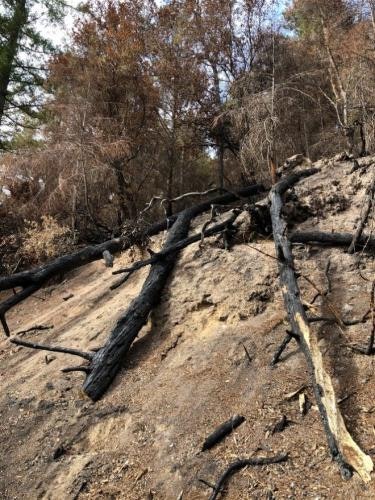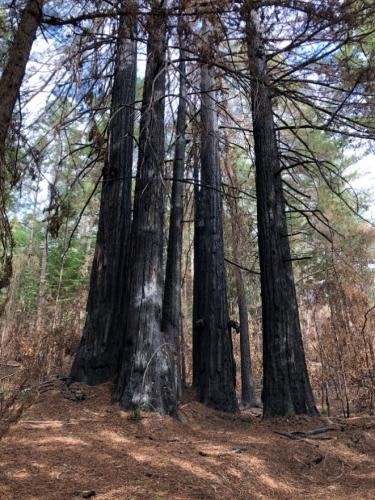Ticks and Fire in Pescadero

In August of 2020, approximately 11,000 bolts of lightning struck the redwood forests of the Santa Cruz Mountains. This event created the CZU Lightning Complex Fire, which ultimately burned a total of 86,509 acres in Santa Cruz and San Mateo Counties. It was the largest fire in San Mateo County history and burned 22,755 acres within the county’s borders. In the path of the fire was Butano State Park, an old-growth redwood forest near Pescadero. Approximately 85% of Butano State Park sustained varying amounts of damage from the CZU Lightning Complex Fire. As of 2023, the forest is slowly recovering. The park is open to the public, but with limited access to trails due to safety risks.
The District regularly monitors parks throughout the county for ticks and tick-borne diseases. Prior to the fire, in February of 2019, staff members collected 225 adult black-legged ticks (Ixodes pacificus) from the South Butano fire road. Of these, four pools were positive for Borrelia burgdorferi (1.8% MIP) and three were positive for Anaplasma phagocytophilum (1.3% MIP). With such a substantial portion of the park affected by fire in 2020, the District wanted to know how quickly ticks would recover and whether fire would change the disease prevalence at the site.

The study began in January of 2021. First, staff needed to determine the severity of the fire by looking at the flame height on the trees, how much of the fallen debris had been consumed, and how many of the smaller trees had survived. They found that the fire damage gradually increased along a 2-mile long fire road from ‘no damage’ to ‘severe damage.’ From January 2021 through July of 2022, staff returned to this trail monthly to determine the rate of vegetation recovery, what species of plants returned, how much top soil was collecting over time, and how much sun exposure each plot had. Between each plot, staff collected ticks which they then tested for tick-borne diseases.
Since January 2021, the District has collected 468 adult and 15 nymphal black-legged ticks. Of these, 385 adult ticks have been individually tested for the Borrelia burgdorferi senso lato (Bbsl) complex which includes the pathogens responsible for Lyme disease and hard-tick relapsing fever (Borrelia miyamotoi). Of the ticks collected, six were positive for Bbsl (prevalence 1.5%) and two were positive for B. miyamotoi (0.52%). No nymphs were positive for either pathogen.
The District has seen a slow recovery of ticks in the area and is beginning its third year of surveillance at the site. Once the year has concluded, the data will be analyzed to see if there are any trends.
Page last reviewed: January 17, 2023
